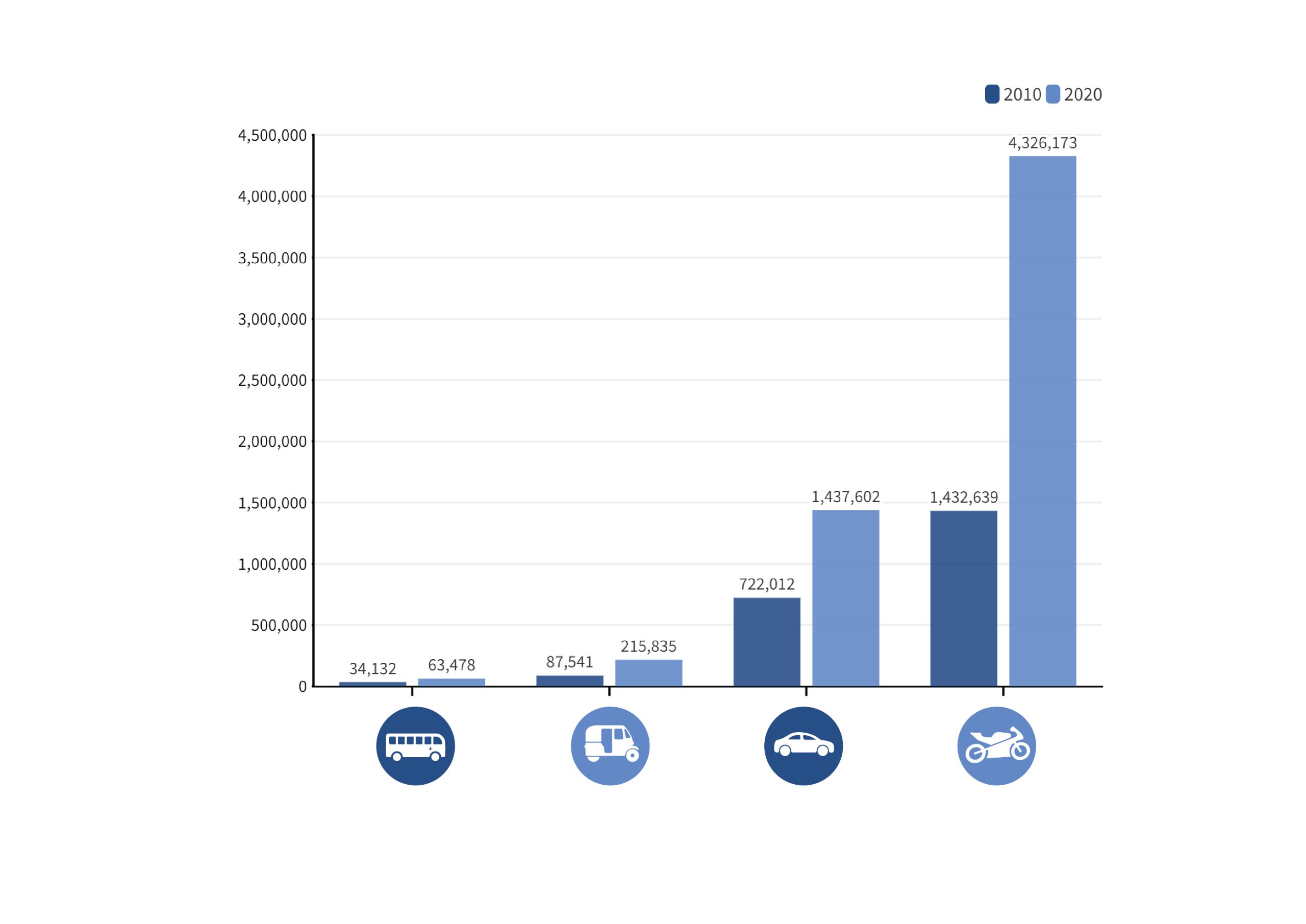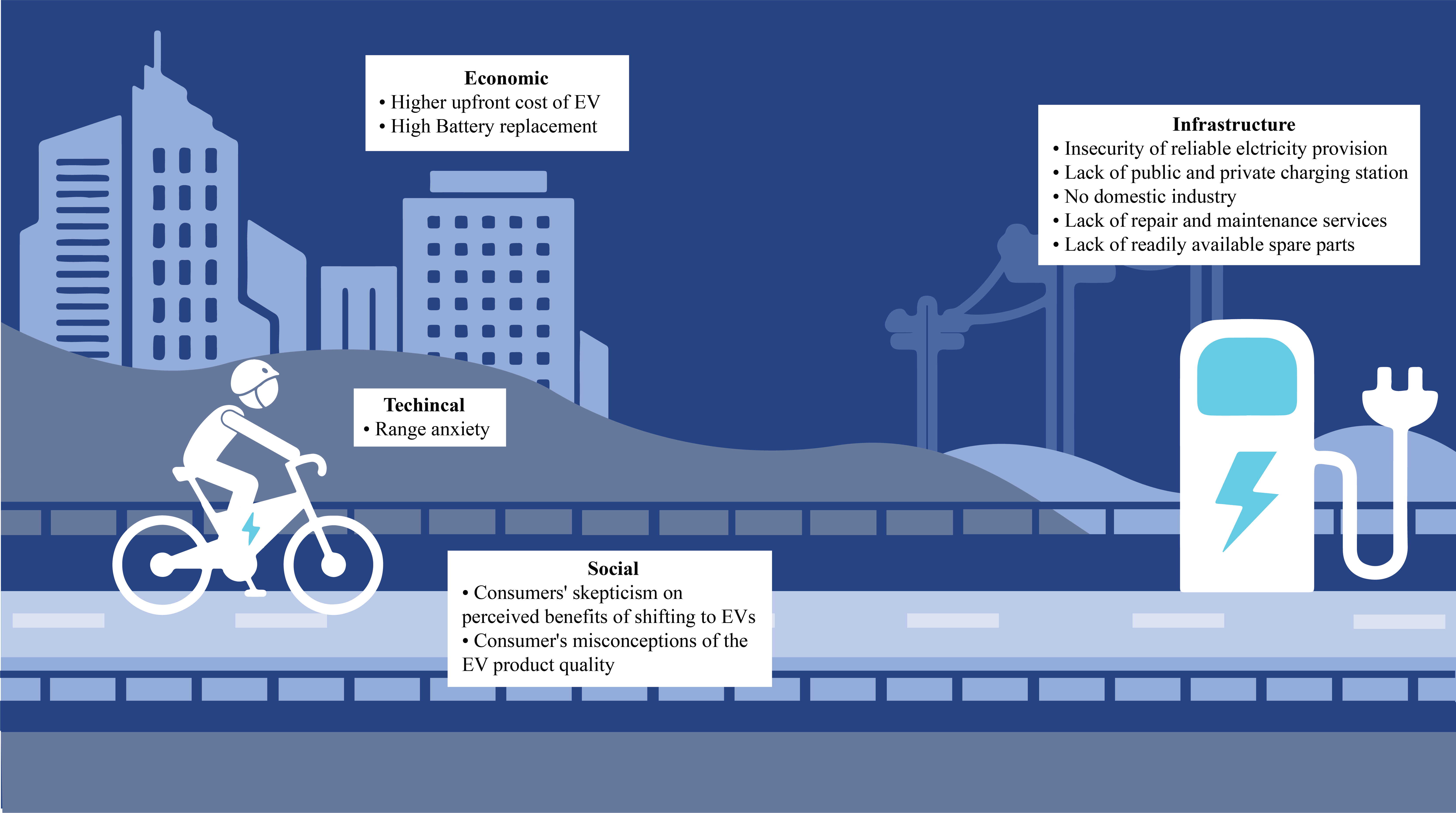Climate and Environmental Crisis: A Ray of Hope Through Uptake of Electric Bikes
Transitioning to e-bikes offers a solution to mitigate the adverse socio-economic impacts of the increasing number of polluting motorbikes.
The rapid pace of urbanization in the South Asian region and Pakistan has led to the growth of urban settlements that are broadly categorized as “messy” and “hidden” (Ellis and Roberts, 2016). Messy, because these settlements lack the provision of basic municipal services and have largely failed to deal with the issues of traffic congestion and environmental pollution. Hidden, because by following an administrative boundary definition, these settlements - typically located on the periphery of cities - are not officially recognized as urban, hence not included in city planning and management proposals. Such constraints considerably offset the benefits from firms and individuals located in close proximity – a phenomenon known as agglomeration economies, which may be an important reason Pakistani cities are not able to realize their full economic potential.
Based on the agglomeration index developed by the World Bank (Uchida and Nelson, 2009), which provides a realistic measure of urbanization, about 55% of Pakistan’s population lives in urban areas (Ellis and Roberts, 2016) as opposed to the official figure of approximately 37% (PBS, 2017). If the trend continues on a similar trajectory, it is expected that by 2050, 75% of the national population will be living in such urban settlements (Yusuf, 2022). With rapid urbanization, associated changes in consumption patterns and lifestyles and their environmental impact are inevitable.
Facilitated by the ease in financial leasing services, one manifestation of these changes is in the number of privately owned vehicles that have significantly increased, by 167% over the last decade (Punjab Development Statistics). Moreover, patterns of urban expansion have also affected the commuting choices of city residents. Urban outgrowth at the peripheries in the form of housing societies have organically followed infrastructural investments such as ring roads, which has resulted in a poorly-regulated horizontal expansion of Pakistan’s main cities – a phenomenon known as sprawl. Such urban sprawl makes the design of feasible mass transit difficult as corroborated by low ridership in the case of the Orange Line Metro Train (OLMT) (Naveed, 2021), as it neither provides direct access to city transport terminals (airport, railway station) nor supports seamless connectivity from commuter's home to city’s financial, commercial, educational and recreational hubs. The limited public transport availability can be gauged from the authors’ estimate that together the mass transit along with its feeder network stations, for those located within 10 minutes of walking distance, just covers 30% of Lahore’s population and hence it is no wonder that a continuous increase in the number of privately owned vehicles is observed. This inefficient outcome of existing mass transit system in Lahore can be traced back to the political economy expediencies that caused deviations in the implemented financial model and technical specification for both the Green Line (Metrobus) and OLMT from the original proposal developed by JICA under the Lahore Mass Transit Plan.
Figure 1 shows an upward trend in the number of registered automobiles in Lahore as reported in Punjab Development Statistics, with autorickshaws and motorbikes increasing more than twice over a decade. Notice the exponential increase in motorbikes that now account for 69% of the city’s vehicular fleet (PDS, 2021), the rising number of on-road internal combustion engine of bikes pose an alarming threat to the city’s air quality. The existing air pollution particularly those from particulate emissions on average reduce life expectancy by 5 years as reported in Pakistan Fact Sheet of Air Quality Life Index. Therefore, any intervention targeted at lowering emissions could play a significant role in improving urban health indicators as the same report highlights a potential gain in life expectancy of 6.8 years for the residents of Lahore by permanently reducing PM 2.5 emissions to the level of WHO standards.

Figure 1: Increase in registered automobiles in Lahore over the last decade
In 2018, a sectoral division of air pollutant emissions in Punjab showed transport sector contributing the highest share (43%), followed by industry (25%), agriculture (20%), and (12%) power generation (FAO, 2019), making transportation an appropriate policy sector to be targeted in any meaningful effort aimed at curbing the city’s emissions. Such interventions can also contribute significantly to reducing the province’s perennial problem of smog with its associated social and economic costs (Sarfraz, 2020), especially in its capital city Lahore where incidence of health problems due to respiratory diseases and allergic reactions linked to urban air pollution sharply increases during the winter months (Jabeen et al., 2021).
Although the government is taking multiple steps to reduce emissions, most of them are either short term measures or face serious challenges of concerted implementation. School closure during the intense smog period last year was one such measure although this was done at the cost of affecting educational activities which already got severely compromised due to the COVID-19 restrictions. For measures such as vehicle inspections (VICS, 2021) and upgrading vehicle emission standards to Euro V (Hussain, 2020), there is still a need for adopting a more focused approach. Since the vehicle inspection and certification of privately owned vehicles is not mandatory (VICS), motorbikes, despite dominating the streets of Lahore, face limited enforcement of fitness certification. A plan aimed at the transition of the most popular mode of transport to an environmentally friendly mode to cope with the increasingly hazardous climatic and environmental threats to society could potentially have a fruitful impact. Learning from international experience, it is observed that by following this approach, private and public entities across the globe are leading a systematic decarbonization effort to address the growing adverse impact of climate change.
In this regard, electric vehicles are an important technological innovation, being adopted worldwide as they produce zero tailpipe emissions. There are multiple benefits of shifting to electric vehicles, particularly electric bikes. Besides reduced socio-economic costs from emissions; electric vehicles, in general, can also play a crucial role in reducing individual fuel costs and lowering national import value. In the FY 2019-20, the consumption of petroleum products was about 19.7 million tons, with the transportation sector driving the demand by using approximately 60% of the total consumption (Trade Development Authority of Pakistan, 2021). In monetary terms, the petroleum import bill during FY 2021-22 surged by 105% to a total of USD 23 billion compared to the previous year (ProPK, 2022). This indicates that exploring the market of electric vehicles would significantly bring down petroleum bills and the reduced vehicle-fuel expenditure can rather be allocated elsewhere, for instance, to combat the damage incurred by climate change.
Why electric bikes?
Multiple factors drive the preference for motorbikes in intracity travel:
- autonomous mobility 24/7 from, and to, anywhere in the city;
- easy parking in clogged commercial centers;
- convenient avoidance of traffic queues;
- financial affordability.
Lahore alone has more than 4 million registered motorbikes (PDS, 2021) and based on our estimates, they consume about 1 billion litres of petrol annually, producing approximately 2.7 million tons of CO2-equivalent emissions. Using the Intergovernmental Panel on Climate Change (IPCC) ‘middle of the road’ scenario (SSP2), which applies a carbon price of $9.05 per ton of CO2-equivalent emission, (Ricke et al., 2018), the socio-economic cost of just Lahore’s motorcycles is approximately USD 24.5 million annually. This cost would increase further if the impact by particulate matter and other pollutants is added. Most government interventions taken so far are based on short term and short-lived measures and do not ensue any hope of long-term improvements.
To mitigate the adverse climate and environment impact, transitioning to e-bikes offers socio-economic benefits by reducing tailpipe emissions to zero. According to the current electricity mix, the emissions induced by generating the additional load to charge e-bikes would be about 70% lesser than those emitted from the exhausts of motorbikes, and shifting electric grid loads to renewable resources could further reduce this cost.
Figure 2 compares the discounted costs of the two bike modes over a 10-year lifespan. Besides the social benefits, the uptake of e-bikes would also offer private savings in the form of reduced annual running and maintenance costs of about PKR 65 thousand and allowing them to recover the higher purchase cost of e-bikes within a year. This saving can be used for various purposes; out-of-pocket health expenditure, paying low-income housing schemes instalments, meeting educational expenses amongst others. For instance, although government schools charge minimal tuition fee, there are other expenditures associated with attaining education such as uniform, school bags, private tuition, etc. Research suggests that on average, in government schools, the cost of education of a primary-level student is approximately PKR 31,000 per annum. The expenditure increases further to PKR 51,000 as we go up the ladder to the secondary school (Alif Ailaan, 2015). This leaves parents with no choice, rendering it unaffordable for them to teach their children. Hence, a saving of PKR 65,000 can be used to meet the educational expenses of children.

Note: The results are based on the authors’ calculations: Specifications of Honda CD70 and Jolta JE-70L, Distance travelled approximately 40km, Fuel price Rs. 224.8 per litre, Residential electricity tariff Rs. 23.1 per kWh, Conversion factor (USD to PKR) 219.62, Discount Rate 12%. The average distance travelled was calculated using data for the distance between residential and commercial areas in Lahore using Google API and the slab for applicable electricity charges was calculated using PSLM/HIES dataset.
What is holding people back from purchasing EVs?
The overpowering impact of the demand and supply-side barriers on electric vehicle adoption has hindered their wider acceptance. To narrow down the key challenges in the uptake of EVs, we gained the perspective of sectoral experts in the context of Pakistan by surveying individuals from the automotive, environment, climate, transport, and development sectors alongside oil and energy distributor companies. Based on the average ratings given to the factors by the survey respondents, figure 3 shows the top 10 challenges blocking the way to fast and smooth adoption of EVs.
The impact of these barriers varies with geographical location and the resulting change in factors such as mobility scenario, purchase power parity, and the readiness towards acceptance of new technology. Two-wheelers in the EV industry has overcome many of these challenges that encourage their adoption. Till June 2022, Jolta Electric had sold 10,000 plus e-bikes with dry batteries within a year (Jolta Electric, 2022) and with the launch of bikes powered by lithium-ion batteries, the sales are expected to increase further.

The repeatedly highlighted barrier in EV adoption by the industry experts was the high upfront cost of electric vehicles, which is mostly attributed to the high battery cost. The battery cost accounts for more than 30% of the upfront cost. With advancements in technologies, Bloomberg NEF projects the battery prices to decrease (BloombergNEF, 2021). This indicates that over time, the usage of lithium-ion batteries will become cheaper and bring down the high initial cost.
The second concern highlighted by the sectoral experts was consumer fear of running out of power before reaching a destination due to a lack of charging infrastructure. Fast chargers at public charging stations reduce the charging time of the vehicles; however, the current numbers of such stations are insufficient to meet the increased demand for fast charging in the future and people would not be willing to wait in long queues for hours to charge their EVs. Although the National EV policy 2019 states that in each major city at least one DC fast charger should be installed in every 3x3 km area, however, there are only a few operational electric vehicle charging stations in Lahore (Ayaz, 2021). To fast-track the adoption of EVs, consumers must be guaranteed a sense of security that they will have access to sufficient charging infrastructure available in close proximities.
For e-bikes, home charging is another option though consumers are concerned about the high electricity voltage and frequency issues that could put their expensive vehicles at risk. Last year during the summer, many complaints were lodged in Lahore due to fluctuating voltage issues, which resulted in the loss of home appliances and short circuits (Dawn, 2021). In addition to this, insecurity of reliable electricity provision with the increasing load shedding nowadays is a growing concern for potential EV buyers. While strenuous efforts need to be made to put in place adequate measures to counter these concerns, two-wheelers to some extent take the burden off the shoulders of their owners. E-bikes take around three hours for a full charge, with a range of 80-90km, which is far more than the average daily distance travelled by motorcyclists, thus eliminating the concern of range anxiety. As the charging time is lesser, the citizens can rely on night-time private charging.
As the domestic market for EVs is yet to expand, the availability of spare parts and technical expertise for repair and maintenance is also a concern for consumers. When hybrid cars entered the fleet, their imported parts were relatively inaccessible. However, as demand for hybrids increased, spare parts came within reach for consumers. This suggests that with a rise in the number of EVs in the industry, spare parts will become more accessible. Furthermore, the technicians would be trained for the repair and maintenance services of these vehicles. In the case of e-bikes, the parts are not much different from motorbikes, and local assembly and manufacturing are being promoted by companies such as Jolta Electric so the availability of spare parts and maintenance services are not a viable reason to hold back their uptake.
Another important obstacle in EV penetration is consumers’ skepticism of the perceived benefits and quality of EVs. However, the worldwide adoption of EVs at a massive scale indicates the growing trust of consumers in the product (Global EV Outlook, 2021).
Parting Thought
Strategic planning and targeted policy framework are the base of leading to an environmentally friendly pathway to electric mobility. As Pakistan is still nascent in the use of EVs, it can benefit by adopting innovations that other neighbouring countries, such as India, have introduced to win the confidence of EV consumers and to support their wider adoption. India, for example, has deployed the swapping battery mechanism – an alternate method of charging electric vehicles (Government of India, 2022) and introduced two packages for daily and monthly subscriptions (The Times of India, 2021). In this case, electric vehicles, instead of charging on public or private charging stations, are energized using swappable batteries. The drained batteries are replaced with fully charged ones at the battery swapping stations. Through a slight modification in this model, the high upfront cost of the vehicle can also be reduced tremendously. For instance, if the batteries are not provided with the vehicle at the time of purchase and are rather owned by a third party that provides the swapping services.
Misconceptions about EVs prevailing in Pakistan can be tackled with a well-administered awareness program and a pilot project, where in the beginning, a few vehicles can be introduced in the city for test runs to win consumers’ trust. In addition to this, proper advertisement targeting consumer benefits from e-bikes can also help clear up misconceptions.
With a large number of bike users in our cities and the continuing trend for this due to structural issues, interventions targeting motorbikes within the transport sector appear to be consequential. The technical concerns can be allayed by adopting some innovative approaches and upfront cost constraint can be relaxed through easier financing, though the monetary incentives and subsidies plans should be designed considering long-term implementation and be gradually revoked as the penetration rate increases since a sudden reduction in the incentives may lead to negative demand shocks. For instance, in China, with sudden decrease in EV subsidies the sales of EVs significantly dropped by 46% in October, 2019 (Reuters, 2019). Thus, gradual modifications in the incentives would prevent such negative demand shocks. There is no doubt that the gains in terms of reduced carbon emissions shall be beneficial for everyone in the long run.
Maham Rasheed is a Research Assistant at Department of Economics in LUMS.
Taram Nayab is a Research Assistant at Department of Economics in LUMS.
Syed Hasan is an Associate Professor at Department of Economics in LUMS.
Mahbub ul Haq Research Centre at LUMS
Postal Address
LUMS
Sector U, DHA
Lahore Cantt, 54792, Pakistan
Office Hours
Mon. to Fri., 8:30 a.m. to 5:00 p.m.





